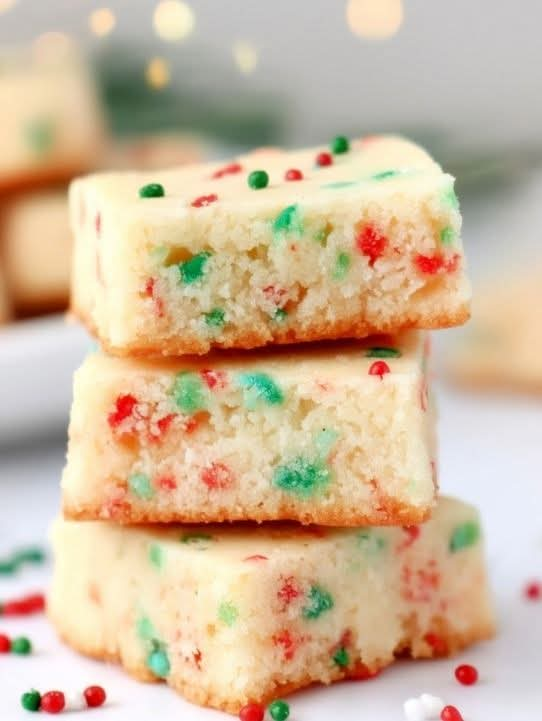Buttery Shortbread Recipe: A Timeless Classic 🍪
Introduction
Shortbread cookies are a classic, irresistible treat that can be traced back centuries. Their crumbly, buttery texture and simple yet delicious flavor have earned them a place in kitchens all over the world. Originating in Scotland, shortbread was once considered a luxury item due to the cost of butter, which was a precious commodity. Today, these buttery delights are enjoyed year-round, with their delicate texture and sweet flavor making them a perfect addition to any tea time or holiday gathering. The beauty of shortbread lies in its simplicity — with just a few ingredients, you can create something truly special.
Ingredients
- 1 cup (2 sticks) unsalted butter, softened
- 1/2 cup granulated sugar
- 2 cups all-purpose flour
- 1/4 cup cornstarch
- 1/4 teaspoon salt
- 1 teaspoon vanilla extract (optional, for added flavor)
- 1 tablespoon powdered sugar (for dusting, optional)
Instructions
- Prepare the Oven and Baking Sheet: Preheat your oven to 325°F (163°C). Line a baking sheet with parchment paper or a silicone baking mat for easy cleanup.
- Cream Butter and Sugar: In a large mixing bowl, cream together the softened butter and granulated sugar until light and fluffy. This will usually take about 3 minutes using an electric mixer. The goal is to incorporate air into the mixture, making the cookies light.
- Mix the Dry Ingredients: In a separate bowl, whisk together the all-purpose flour, cornstarch, and salt. The cornstarch helps to create that signature melt-in-your-mouth texture by making the dough more delicate.
- Combine Wet and Dry Ingredients: Gradually add the dry ingredients into the butter-sugar mixture. Mix gently until everything is just incorporated. The dough will be a bit crumbly at first, but that’s exactly what you want. If using vanilla extract, stir it in at this stage.
- Form the Dough: Turn the dough out onto a clean, lightly floured surface. Gently knead the dough into a ball. If the dough feels too soft or sticky, chill it in the fridge for 15–20 minutes before rolling.
- Roll and Shape: Roll the dough out to about 1/4 inch thick. You can use a rolling pin or your hands to press the dough flat. Cut the dough into rectangles or squares using a knife or cookie cutter. Alternatively, you can also shape them into rounds.
- Bake: Place the shortbread shapes onto your prepared baking sheet, spacing them about an inch apart. Bake for 15–18 minutes, or until the edges just begin to turn golden brown. Keep an eye on them as baking times may vary based on your oven.
- Cool and Finish: Let the shortbread cool on the baking sheet for a few minutes, then transfer them to a wire rack to cool completely. If desired, dust with powdered sugar for an extra touch of sweetness.
Methods of Formation
There are several methods you can use to shape and bake your shortbread cookies, depending on the presentation and texture you prefer.
- Traditional Scottish Style (Fingers): The classic shortbread shape is a simple “finger” — rectangular and about 3-4 inches long. After baking, these can be dusted with powdered sugar or even dipped in chocolate for added flavor.
- Round Shape: Roll the dough into a log and slice it into rounds for a clean, uniform look. This is a great option if you’re after a neat, rustic appearance.
- Cut-Outs: If you’re feeling more creative, use cookie cutters to make fun shapes, such as stars, hearts, or circles. This method is especially popular during the holiday season when decorating cookies is part of the fun.
- Pressed Shortbread: For a more delicate, melt-in-your-mouth texture, you can also press the dough into a tart pan or an 8-inch square pan. After baking, cut into small squares or bars for an easy, bite-sized treat.
History of Shortbread
Shortbread dates back to the 12th century, where it was originally made from a simple mixture of bread dough and butter. In medieval times, it was baked twice, in a process similar to biscotti. However, it wasn’t until the 16th century that shortbread evolved into its modern form. The addition of sugar (a rare and expensive commodity) and the use of fine flour marked the transition from a peasant’s bread to an aristocratic treat.
The word “short” in shortbread comes from the Old English word “short,” which means crumbly or brittle — a perfect description of the texture. Traditionally, shortbread was made in Scotland, especially around Christmas and New Year’s, but over time, the recipe spread to other parts of the world.
The most famous brand of shortbread is Walkers, founded in 1898 in Scotland, which popularized the iconic Scottish shortbread finger. Today, shortbread is enjoyed in many forms worldwide, and its simple yet rich flavor makes it a favorite in countless households.
Conclusion
Whether you enjoy them with a hot cup of tea, as an after-dinner treat, or just as a comforting snack, buttery shortbread cookies are a timeless favorite. Their simplicity is their charm — just a few ingredients and some patience yield the perfect cookie. The beauty of shortbread is that it’s as easy as it is versatile. With endless opportunities to shape, decorate, and customize, you can make it your own. If you’re a fan of buttery, crumbly, melt-in-your-mouth treats, you can’t go wrong with this classic shortbread recipe.
For Lovers of Shortbread
Shortbread lovers are loyal to the simplicity and perfection of these cookies. Some enjoy the buttery richness as-is, while others might dip them in chocolate or add a sprinkle of sea salt for a little contrast. Whether you’re baking a batch for a special occasion or enjoying them alone, there’s something comforting about the presence of these delightful cookies. They have a timeless appeal and a versatility that never goes out of style.
